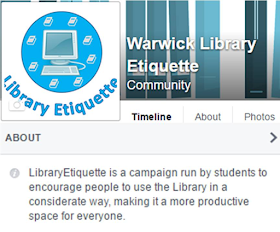Problem:
There
are over 23,000 students at the university but only enough facilities for a
small fraction (Warwick University, 2015). Seat hogging is therefore a common occurrence in the library,
as well as using computer desk spaces for written or laptop work and talking on
silent floors. This is inconsiderate and an urgent problem. A change is necessary
in order to maximise the availability and efficiency of the limited library
space. The upcoming exam period justifies this as talking on silent floors
disrupts the learning of students who require silence in order to work
efficiently. Further justification resides in the fact that certain courses may
require specialist software which are exclusively available on Warwick
computers (e.g. SPSS).
Solution:
Our
project aimed to promote ‘library etiquette.’ In an attempt to change the said
behaviour, we dispersed posters promoting the proper ‘library etiquette’ - that is, the opposite behaviour to the common problem behaviours exhibited. These posters were placed around
the library and within the Psychology common room. They included
various persuasive techniques known to be effective in influencing behaviour.
Rhetorical questions, social proof and guilt/fear are just three examples of techniques which have been used due to evidence showing their success in influencing behaviour changes (Cialdini,
2009; Burnkrant & Howard, 1984; Dillard & Anderson, 2004).
We also created a Facebook page to share the posters online. This allowed us to reach a wider audience and reinforced the messages we were promoting. This follows the mere exposure effect, a technique which indicates individuals prefer, and are more receptive towards, familiar faces (Zajonc, 2001).
References
Burnkrant, R. E., & Howard, D. J. (1984). Effects of the use of introductory rhetorical questions versus statements on information processing. Journal of Personality and Social Psychology, 47, 1218-1230.
Cialdini, R. B. (2009). Social Proof: Truth Are Us. Influence: Science and Practice USA: Pearson Education Inc.
Dillard, J. P., & Anderson, J. W. (2004). The role of fear in persuasion. Psychology & Marketing, 21,909-926.
Warwick University. (2015). Retrieved from https://www2.warwick.ac.uk/about/profile/people/
Zajonc, R. B. (2001). Mere exposure: A gateway to the subliminal. Current Directions in Psychological Science, 10, 224-228.
Zajonc, R. B. (2001). Mere exposure: A gateway to the subliminal. Current Directions in Psychological Science, 10, 224-228.




No comments:
Post a Comment
Note: Only a member of this blog may post a comment.